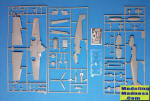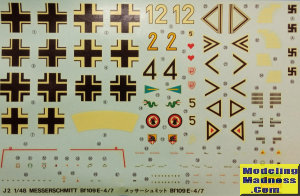
| KIT #: | J2 |
| PRICE: | $10.00 on sale |
| DECALS: | Seven options |
| REVIEWER: | Spiros Pendedekas |
| NOTES: |

| HISTORY |
The Messerschmitt Bf 109E-4 was essentially an E-3 with improved square canopy, whereas the E-7 was a long range E-4 with a provision of a 300lt external tank under the fuselage. Fully covered pointy spinners were also used on occasion. E-4/7s were, until the appearance of the F version, the workhorses of the Luftwaffe, being utilized to all theaters of operation.
| THE KIT |
 Hasegawa Bf-109E-4/7 series appeared in 1988, together with the E-3 series.
As was the case with the E-3, the rear fuselage was thin and the top cowling
had wrong shape, with Hasegawa wasting no time in correcting the molds
(attainable with no big drama, as they basically had to “only” shave some
material off the existing molds), with the improved kits prefixed as “Jt”
instead of the initial “wrong” ones that were prefixed simply “J”.
Hasegawa Bf-109E-4/7 series appeared in 1988, together with the E-3 series.
As was the case with the E-3, the rear fuselage was thin and the top cowling
had wrong shape, with Hasegawa wasting no time in correcting the molds
(attainable with no big drama, as they basically had to “only” shave some
material off the existing molds), with the improved kits prefixed as “Jt”
instead of the initial “wrong” ones that were prefixed simply “J”.
The “J” kits were thus rendered obsolete, meaning the unsold ones were
practically leftover kits to avoid. Since it is generally regarded that,
though “wrong”, those kits' faults are not that noticeable but to the more
experienced eye or by the presence of a correct kit, these unsold initial
release kits somehow found their way to the market, usually offered at
bargain prices. Such was the case of the subject of this preview, which was
bought for a mere $10 in 2005, with five Molak enamels for the basic camo
included, so the deal was fair at least.
The kit comes in the usual excellent Hasegawa top opening box, featuring yet
another amazing Koike Shigeo box art, this time of Major Helmut Wick’s Bf
109E-4 dogfighting with a Spitfire. Upon opening the box, I was greeted with
55 light gray styrene parts arranged in three equally sized sprues. Molding
was superb with no apparent flash.
Upon looking at the kit’s contents, it became pretty evident that the sprues
are almost identical to Hasegawa’s Bf 109E-3 kit, with some extra parts
added (the drop tank, its pylon and optional pinner). The clear fret is also
different, to cater for the different canopy.
Cockpit is
reasonably appointed for the scale and the kit’s 1998 origins, with the
instrument panel featuring nice molded-on details, the side walls being
relatively busy, the seat having belts molded-on and the stick and rudder
pedals looking good as well.
Flaps and slats are
separate and can be posed dynamically. All other key areas, like the landing
gear, wheel bays, radiator and oil coolers are sufficiently detailed. A good
looking MA fret (but of the harder not too modeler friendly stainless steel
type) is included to beef up areas like the radiator and oil coolers faces.
Clear parts are nicely done, whereas instructions are the usual Hasegawa
very nice pamphlet, containing a short history and differences of the
specific type, a parts list, with the seemingly easy construction spread in
8 clear and followable steps.
 Seven Luftwaffe schemes are provided, all more or less similar in general
layout (top in splinter, bottom and sides in light blue with the occasional
side mottling done very interestingly and yellow or white cowlings and/or
rudders), including two Helmut Wick’s machines, a Joachim Munchenberg’s, two
Hans “Assi” Hahn’s, a Gunther Rutzow’s and a Peter-Paul Steindl’s. Decals
have the whites represented as ivory, but are otherwise excellently printed
and, apart from some yellowing, look to be in usable condition.
Seven Luftwaffe schemes are provided, all more or less similar in general
layout (top in splinter, bottom and sides in light blue with the occasional
side mottling done very interestingly and yellow or white cowlings and/or
rudders), including two Helmut Wick’s machines, a Joachim Munchenberg’s, two
Hans “Assi” Hahn’s, a Gunther Rutzow’s and a Peter-Paul Steindl’s. Decals
have the whites represented as ivory, but are otherwise excellently printed
and, apart from some yellowing, look to be in usable condition.
Instructions want
you to first assemble the cockpit and radiator inlet, then trap them between
the fuselage halves. Assembly and installation of the wings is next, where
you can pose the slats and flaps to your preference, followed by assembly
and installation of the landing gear and horizontal stabilizers.
Prop installation comes next, where you have to choose the spinner type for
the version you are building, followed by attachment of a bomb or drop tank
(again, rearding the specific version).Some final bits and pieces and the
transparencies are finally to be attached, ending a seemingly easy and
pleasant construction.
| CONCLUSIONS |
As is the case with the initial release E-3, this initial “uncorrected”
E-4/7 version is for the rest a kit that looks good in the box with
sufficient detail, seemingly good fit, nice transparencies and still usable
decals. Instructions are well written and the build is promised to be
uncomplex.
If you do not
bother with the kit’s inaccuracies (which, truth be told, are not deadly
serious) and look for a pleasant build, this is a kit worth tackling.
Happy Modeling!
N
ovember 2022
Copyright ModelingMadness.com. All rights reserved. No
reproduction in part or in whole without express permission.
If you would like your product reviewed fairly and fairly quickly, please
contact the editor or see other details in the
Note to
Contributors.